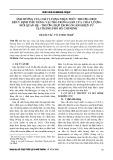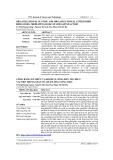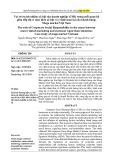
P-ISSN 1859-3585 E-ISSN 2615-9619 https://jst-haui.vn LANGUAGE - CULTURE Vol. 60 - No. 12 (Dec 2024) HaUI Journal of Science and Technology
155
THE MANIFESTATION OF INDIVIDUALISM IN AMERICAN AND VIETNAMESE ADVERTISEMENTS THROUGH SOCIAL-PERCEPTION THEMES
SỰ THỂ HIỆN TÍNH CÁ NHÂN TRONG QUẢNG CÁO CỦA MỸ VÀ VIỆT NAM THÔNG QUA CÁC CHỦ ĐỀ NHẬN THỨC XÃ HỘI Pham Thi Tam1,* DOI: http://doi.org/10.57001/huih5804.2024.431 1. INTRODUCTION Many scholars have been fascinated by the juxtaposition of individualism and collectivism in advertising concepts. Their investigation has yielded mixed and contradictory outcomes. The cultural congruence hypothesis is supported through comparative analysis of Eastern and Western advertising with mixed findings [4, 11]. Some studies have not found any difference between Eastern and Western advertising in the use of individualism and collectivism [3]. Few studies comparing advertisements of different product origins (i.e., imported, joint venture, and domestic products) revealed a similar pattern of mixed, conflicting, and inconclusive findings. However, individualism-collectivism dimension (I-CD), especially regarding its manifestation in Vietnamese context, is still a fertilized land for any Vietnamese researchers to set their basis on. 2. THEORETICAL FRAMEWORK 2.1. Individualism and collectivism dimension (I-CD) Hofstede’s [8, 9] Individualism-Collectivism (I-C) dimension explains variations in human psychology and behavior across cultures and individuals. Western cultures (e.g., the U.S., Australia, ABSTRACT This cross-
cultural research utilizes a content analysis approach to explore how individualism
is represented through individualist social-
perception themes in advertisements. A total of 131
advertisements from American magazines and 123 from
Vietnamese magazines were chosen for
this analysis due to their representative qualities, with one originating from an individualistic
culture and the other from a collectivist culture, including the previously underexamined
Vietnamese context. The results indicate that social-
perception themes reflecting individualism
are more frequently found in the American dataset compared to the Vietnamese dataset. These
findings support the theoretical frameworks of individualism and collectivism. The depiction of
the
se themes in advertising holds significant importance, and incorporating cultural values into
advertising is consistently relevant and necessary. Keywords: Individualism; collectivism; advertisement; manifestation; cross-cultural. TÓM TẮT Nghiên cứu đối chiếu văn hóa này sử dụng phương pháp phân tích nội dung để chỉ ra biểu đạ
t
tính cá nhân thông qua các chủ đề nhận thức luận xã hội trong quảng cáo. 131 quảng cáo chọn lọ
c
trên các tạp chí Mỹ và 123 quảng cáo chọn lọc trên tạp chí Việt Nam được lựa chọn để nhận diện s
ự
biểu đạt này do những đặc điểm tiêu biểu của chúng, một lựa chọn từ nền văn hóa cá nhân và mộ
t
lựạ chọn từ văn hóa tập thể và bối cảnh Việt Nam chưa được nghiên cứu. Kết quả nghiên cứu cho thấ
y,
các chủ đề nhận thức luận xã hội biểu đạt tính cá nhân có thể được tìm thấy phổ biến hơn trong tậ
p
dữ liệu của Mỹ so với dữ liệu của Việt Nam. Những kết quả này một lần nữa khẳng định cơ sở lý thuyế
t
về tính cá nhân và tính tập thể, sự thể hiện của chúng trong quảng cáo vẫn có giá trị lớn và khẳ
ng
định việc tích hợp các giá trị văn hóa vào quảng cáo luôn được quan tâm và cần thiết. Từ khóa: Tính cá nhân; tính tập thể; quảng cáo; sự biểu đạt; đối chiếu văn hóa. 1Faculty of Foreign Languages, Academy of Finance, Vietnam *Email: phamthitam@hvtc.edu.vn Received: 03/11/2024 Revised: 15/12/2024 Accepted: 26/12/2024

VĂN HÓA https://jst-haui.vn Tạp chí Khoa học và Công nghệ Trường Đại học Công nghiệp Hà Nội Tập 60 - Số 12 (12/2024)
156
NGÔN NG
Ữ
P
-
ISSN 1859
-
3585
E
-
ISSN 2615
-
961
9
Western Europe) are more individualistic, while Eastern cultures (e.g., China, Japan, Korea) influenced by Confucian traditions are more collectivist [15]. Triandis [30] highlighted I-C differences in self-construal, social perception, emotions, motives, and communication styles. Collectivists see themselves as interdependent, prioritize group welfare, and value harmony, loyalty, and social approval. They respect norms, social roles, and hierarchies. In contrast, individualists view themselves as independent, prioritize personal achievement, and value competition, individuality, and equality, often disregarding group norms and welfare [1, 13, 14]. 2.2. Cultural Values and Advertising: A Symbiotic Relationship Research shows that advertisers understand the importance of cultural values and embed them into advertising messages [27]. Ads highlight product-related values, such as quality, emphasize values achievable through use, like social popularity, and associate aspirational values, such as trustworthiness, with the product [6]. This strategy creates a transfer of values, linking cultural ideals to the product and consumption experience. As a result, cultural values are central to advertising, reflecting societal preferences and orientations. Ads also influence cultural norms, shaping lifestyles and consumption habits. Acting as both carriers of information and cultural values, advertisements play a dual role in social communication, impacting how people interact with and internalize these values [25]. While research on cultural values in advertising has been conducted in countries like India [12], Japan [23], Korea [21], and Hong Kong [31], Vietnam’s context remains underexplored. This lack of research presents an opportunity to examine how Vietnamese advertising reflects and shapes cultural values, addressing a significant gap in the literature. Cultural values and advertising are closely related, with advertising both reflecting and influencing social norms. While extensively studied in other cultural contexts, Vietnam’s advertising landscape offers fertile ground for research into the mutual relationship between culture and advertising. 2.3. Individualism and collectivism through advertising themes in previous studies Research on cultural values in advertising often focuses on themes of individualism and collectivism in Eastern and Western contexts. Advertising themes, defined as central messages revealing cultural content [32], serve as a lens for examining cultural profiles through appeals like independence or group harmony [3, 4]. Pollay [27] developed a framework analyzing cultural values in advertising, though its single-dimensional focus on individualism and collectivism has limitations. Muller’s [22] comparison of Japanese and American magazine ads found that Japanese advertisers, contrary to expectations, used more individualist appeals (e.g., independence, uniqueness) and fewer group-oriented appeals (e.g., consensus, conformity). Japanese ads also emphasized traditional values and soft-sell approaches, leading to mixed findings on cultural congruence. Cheng and Schwitzer [3] studied Chinese and American TV commercials, finding no significant differences in individualist or collectivist appeals. However, certain themes like competition and enjoyment were more prominent in American ads, while patriotism and popularity appeared more in Chinese ads. These findings highlight the multidimensional nature of cultural values under the individualism-collectivism (I-C) framework. Han and Shavitt [7] examined Korean and American magazine ads, revealing that Korean ads focused on collectivist appeals like family integrity and group harmony, while American ads emphasized individualist appeals such as ambition, self-improvement, and personal goals. Cho et al. [4] found similar patterns, with American ads showing more individualist appeals in themes and execution, but no significant differences in collectivist appeals between American and Korean ads. Lin [17] observed that American TV ads favored hard-sell and individualist appeals, while Chinese ads leaned toward veneration for elders and group consensus. Zhang’s [32] framework addressed limitations in previous studies by incorporating multidimensional constructs of individualism and collectivism, providing a comprehensive tool for analyzing cultural themes in advertising. Zhang [32] created a framework for examining how themes in advertising relate to individualism and collectivism as cultural factors. This approach emphasizes how ads that represent the dominant cultural values of a country are more likely to resonate. While collectivist cultures place more emphasis on interpersonal relationships, harmony, and communal benefits, individualistic cultures place more emphasis on themes like self-expression, independence, and personal achievement. Drawing on earlier studies by Hofstede [8]

P-ISSN 1859-3585 E-ISSN 2615-9619 https://jst-haui.vn LANGUAGE - CULTURE Vol. 60 - No. 12 (Dec 2024) HaUI Journal of Science and Technology
157
and Markus and Kitayama [20], Zhang's study emphasizes the significance of adjusting advertising methods to cultural contexts, building on cross-cultural psychology. According to Zhang's paradigm, competition, nonconformity, and uniqueness are the three main factors that underpin advertising techniques in individualistic societies. Competition frequently pushes consumers to perform better than their peers, marketing prestigious goods linked to achievement. Non-conformity appeals to those who prioritize individuality and autonomy, often seen in ads for fashion and technology products. Finally, uniqueness is tied to non-conformity, with ads focusing on products that help consumers distinguish themselves from the crowd, reflecting individualistic values of personal advancement and self-expression. Despite extensive research in other countries, Vietnam remains underexplored. Applying Zhang’s framework to compare American and Vietnamese advertisements could provide valuable insights into the manifestation of individualist social-perception themes in these cultural contexts. In the scope of this research, social-perception themes including competition, non-conformity and uniqueness are under further investigation with a comparison between American and Vietnamese advertisements. 2.4. Methodology 2.4.1. Research questions The aim of this study was to pinpoint the manifestation of individualism in American and Vietnamese advertisements through social perception themes. To fulfill this aim of the study, the following research question was formulated: At which levels, social perception themes denoting individualism are represented in selected American and Vietnamese advertisements? 2.4.2. Research data and research methods Research data A total of 131 full-page color advertisements from American magazines and 123 from Vietnamese magazines were randomly selected for this study. The American dataset includes advertisements from Forbes (U.S.), Women's Health, and Reader's Digest, while the Vietnamese dataset features ads from Forbes Vietnam, Thế giới phụ nữ (Women's World), and Tiếp thị & gia đình (Marketing and Family). These magazines were published between April and July in the years 2018, 2019, and 2020. The selection of magazine categories, timeframe, and advertisement types was designed to ensure the comparability and reliability of the data, thereby supporting the validity of the study's findings. A detailed description of the advertisement distribution is provided in Table 1. Table 1. Distribution of magazine advertisements American samples Vietnamese samples Timeline: February to July 2018 -2020 Reader’s Digest 32% Tiếp thị & gia đình (Marketing and Family) 37.4 (%)
Women’s Health 32.9% Thế giới phụ nữ (Women’s World) 28.6 % Forbes U.S 35.1% Forbes Vietnam 34 % Data collection procedures Collecting data for this study is conducted as procedures below. - Finding out lists of American and Vietnamese magazine categories which are popular advertising vehicles with high circulation, similar target audiences for maintaining comparability in both countries. - Deciding the timelines for the magazines chosen. - Collecting all the advertisements in those issues selected (Omitting the advertisements translated). - Reading the advertisements, categorizing, and describing the sample advertisements, omitting the ones in cases when more than one advertisement is found for the same brand. Only one is randomly chosen to avoid inflating the sample size, thereby reducing the effect of brand-specific advertising expressions and advertisements which are foreign, universal and translation ones. Research methods Content analysis has been widely used in studies comparing cultural values in advertising, with researchers such as Lin [17], Maheswaran and Chaiken [19], and Zhang [32] employing this method in related fields. Comparative content analysis allows for unobtrusive observation of social processes in real time, enhancing external validity by analyzing media messages in their natural context (Elo & Kyngas, 2008). Consequently, this method is well-suited for the present study, which follows the research phases outlined by Elo and Kyngas [5] as Figure 1. Then the results will be divided by the total number of sentences and phrases in each dataset (131 American ads

VĂN HÓA https://jst-haui.vn Tạp chí Khoa học và Công nghệ Trường Đại học Công nghiệp Hà Nội Tập 60 - Số 12 (12/2024)
158
NGÔN NG
Ữ
P
-
ISSN 1859
-
3585
E
-
ISSN 2615
-
961
9
and 123 Vietnamese ads) to get the total result for each kind of images. Finally, these results in American ads and Vietnamese ads are then specified and compared with each other to pinpoint the similarities and differences between the two datasets in the manifestation of individualism and collectivism in American and Vietnamese advertisements. Figure 1. The phases of content analysis in this study (adapted from [5]) 3. FINDINGS AND DISCUSSIONS Social perception themes are divided into individualist and collectivist ones. Individualist social perception themes contain competition, non-conformity and uniqueness [32]. The individualist social perception themes listed above are present in both sets of data at diverse levels. Figure 2. Social perception themes representing individualism present in American ads and Vietnamese ads As presented in Figure 2, individualist social perception themes are used more often in American ads than in Vietnamese ads with the difference of 1.6 % for uniqueness, 3.1 % for competition and 11.1% for non-conformity. Non-conformity demonstrates the biggest difference while uniqueness has the smallest gap between the two datasets. In general, these three individualist social perception themes are more dominant in American ads than in Vietnamese ads. Competition Competition, encompassing themes of competitiveness, superiority, and explicit or implicit comparisons [32], appears in both datasets as an individualist social perception. For example, the sentence, “More than anyone else, we understand that each customer is an individual with their own aspirations and ambitions in life” (ANZ bank, Forbes Vietnam, 2018), reflects superiority. Similarly, “Top 40 most valuable Vietnamese corporate brands in 2018” (HD Bank, Forbes Vietnam, 2018) highlights competitiveness, while “Now the most complete eye multivitamin is here” (Reader’s Digest, 2018) implies superiority. The findings reveal competition in both American and Vietnamese ads at moderate levels, with 10% in American ads and 6.9% in Vietnamese ads. American advertisements demonstrate a broader use of competition, consistent with cultural traits emphasizing individuality, success, and competitiveness [10]. Although less prominent, this individualist value also holds significance in Vietnamese ads. The study aligns with prior research [3, 32] and provides insights into individualist values in Vietnamese advertisements. However, the generalizability is limited by the dataset. Future research could explore competition themes in other Vietnamese ad sets and evaluate their effectiveness in both cultural contexts. Non-conformity The non-conformity theme, encompassing individuality, originality, boldness, disregard for norms, and a carefree spirit [32], has garnered significant research interest. Examples include the ad line “No, your nose isn’t broken; your brain is just bored with your signature scent” (Women’s Health, 2018), reflecting a carefree spirit, and “Yeah. You are doing it right.” (Women’s Health, 2018), indicating boldness and impulsiveness. Similarly, “ONLY Eggland’s Best lets you show the Organic love so tastefully” (Women’s Health, 2018) highlights distinctiveness. This theme appears in 11.8% of American ads but only 0.07% of Vietnamese ads, a disparity of over 11 times.

P-ISSN 1859-3585 E-ISSN 2615-9619 https://jst-haui.vn LANGUAGE - CULTURE Vol. 60 - No. 12 (Dec 2024) HaUI Journal of Science and Technology
159
These findings align with cultural differences, as Americans value adaptability, acceptance of change, and progression [10], making non-conformity more prevalent in individualist cultures [3, 33]. While consistent with prior research and cultural traits, the limited presence of this theme in Vietnamese ads and the large disparity suggest further studies are needed to confirm these results. Uniqueness The theme of uniqueness reflects rarity, unparalleled qualities, and distinct product features and benefits [32]. Examples include the ad slogan “Three continents, One truly global MBA” (Forbes U.S., 2018), highlighting a business school’s rarity across continents, and “Only big thinkers could turn steel into oxygen” (Forbes U.S., 2018), showcasing a company’s unrivaled innovation. Uniqueness has been identified as key to effective advertising, enhancing recall and learning [16] and attracting attention due to the cognitive processing it demands [26]. Ads with unique content often generate stronger evaluative responses [2] and are more effective overall [18]. While uniqueness is linked to individualist social perception, it appears in 11.5% of American ads and 9.5% of Vietnamese ads - a minimal difference. This finding contrasts with Cho et al. [4] and Mueller [22] but aligns with Zhang [32], indicating that uniqueness is a shared advertising strategy in both cultures. 4. CONCLUSIONS AND IMPLICATIONS This study reveals that Vietnamese advertisements effectively incorporate individualist values into local markets, demonstrating their prominence, while American ads continue to emphasize these values. The findings support the notion that social perception themes have strong potential for success across diverse markets. At the same time, the study highlights that, despite the growing influence of Western cultural values, traditional Vietnamese culture remains intact in commercial communication. It confirms a higher frequency of individualist values in the selected Vietnamese advertisements, providing empirical support for both Westernization and localization arguments. This serves as a foundation for future research into cultural and persuasive effects, as well as the mechanisms driving these observed trends in Vietnamese and other advertisements, particularly regarding individualist themes. Additionally, the study contributes to a better understanding of non-essentialist cultural perspectives in value research. In a globally integrated world, where cultural collisions lead to change, traditional cultural values continue to shape unique national identities. REFERENCES [1]. Aker J. L., Maheswaran D., “The effect of cultural orientation on persuasion,” Journal of Consumer Research, 24 (4), 315-328, 1997. [2]. Ang S.H., Low S. Y. M., “Exploring the dimensions of ad creativity,” Psychology and Marketing, 17 (10): 835–54, 2000. https://doi:10.1002/1520-6793(200010)17:10<835: AIDMAR1>3.0.CO;2-#. [3]. Cheng H., Scheweizer J. C., “Cultural values reflected in Chinese and U.S television commercials,” Journal of Advertising Research, 3, 27-45, 1996. [4]. Cho B., Kwon U., Gentry J. W., Jun S., Kropp F., “Cultural values reflected in theme and execution: A comparative study of U.S. and Korean television commercials,” Journal of Advertising, 28 (4), 59-73, 1999. [5]. Elo S., Kyngäs H., “The qualitative content analysis process,” Journal of Advanced Nursing, 62, 107-115, 2008 [6]. Goldman R., Reading ads socially. Routledge, 1992. [7]. Han S.P., Shavitt S., “Persuasion and culture: advertising appeals in individualistic and collectivistic society,” Journal of Experimental Social Psychology, 30, 326-350, 1994. [8]. Hofstede, G., Culture’s consequences: Comparing values, behaviors, institutions, and organizations across nations. Thousand Oaks, CA: Sage, 1980. [9]. Hofstede G., Cultured consequences (2nd ed). Thousand Oaks, C.A: Sage, 2001. [10]. Jewett G.W., Pasadena Herald Tribune. Pasadena, California, 2005. [11]. Ji M. F., McNeal J. U., “How Chinese children’s commercials differ from those of the United States: A content analysis,” Journal of Advertising, 30 (3), 78-92, 2001. [12]. Khairullah D. H. z., Khairullah Z. Y., “Cross-cultural analysis of gender roles: Indian and US advertisements,” Asia Pacific Journal of Marketing and Logistics, 21(1), 58–75, 2009 [13]. Kitayama S., Na J., Colleagues, “Behavioral profiles of social orientation and cognitive style across cultures,” Journal of Personality and Social Psychology, 97(6), 892–907, 2009. [14]. Kitayama S., Colleagues, “Within-person variability and its role in cultural psychology,” Journal of Cross-Cultural Psychology, 54(4), 673–691, 2023. [15]. Kim U., Triandis H. C., Kâğitçibaşi Ç., Choi S.C., Yoon G., Individualism and collectivism: Theory, method, and applications. Sage Publications, Inc., 1994.


























